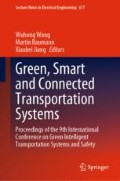Abstract
Metro train bogie system is located between the car body and the track, which is one of the key subsystems to ensure the safety of train operation. As a complex system, bogie system is composed of many components, once the failure happened, it would impact the normal operation of the whole train. In order to better predict the failure rate of bogie system, radial basis function (RBF) neural network is introduced to predict the failure rate of the whole system through the fault data of bogie components, and genetic algorithm is used to optimize the model. Experimental results showed that the proposed method can accurately predict the bogie failure rate, and can be used as a system-level reliability prediction method, providing a data basis for later system improvement and optimization.
Access this chapter
Tax calculation will be finalised at checkout
Purchases are for personal use only
References
Xia J (2014) Research on reliability analysis and application of metro door system. Nanjing University of Science and Technology, Nanjing
Hu C, Yao J (2012) Reliability analysis for electric multiple units based on fault tree Monte Carlo method. China Railway Sci z1:52–59
Wang H, Lu Z, Zhang B (2012) Analysis method for the operational reliability of EMU running gear based on fault tree and Bayesian network. China Railway Sci z1:60–64
Meng L, Liu Z, Diao L et al (2016) Reliability evaluation of high-speed train traction transmission system based on Markov model. J China Railway Soc 8:23–27
Qin Y, Fu Y, Li W et al (2018) Operational safety and reliability assessment of high speed train with intuitionistic fuzzy set and VIKOR method. J Beijing Univ Technol 44(1):112–119
Li L, Cheng X, Qin Y et al (2013) Reliability prediction of urban rail transit vehicle based on BP neural network. J Central South Univ (Science and Technology) 1:42–46
Zhou Q, Deng Y, Chen J (2010) The RBFNN application in fault diagnosis for the subway train. Comput CD Softw Appl 11:71–72
Song Y, Zhu M (2014) Subway sensor fault diagnosis based on radial neural network. Urban Mass Transit 5:94–97, 101
Yin H, Wang K, Zhang T (2015) Fault prediction based on PSO-BP neural network about wheel and Axle Box of Bogie in urban rail train. Complex Syst Complexity Sci 4:97–103
Hartman E, Keeler JD, Kowalski JM (2008) Layered neural networks with Gaussian hidden units as universal approximations. Neural Comput 2(2):210–215
Zhou P (2013) Design and application of neural network based on Matlab. Tsinghua University Press, Beijing
Yu J (2012) Reliability analysis and application research of key system of metro vehicles. Beijing Jiaotong University, Beijing
Zeng Y (2015) RBF natural network based on genetic algorithm used in maximum power point tracking of photovoltaic system. Hunan University of Technology, Zhuzhou
Chen A (2007) Research on data prediction method based on BP and RBF neural networks. Central South University, Nanjing
Chen M (2006) Study of submarine’s displacement and principal dimensions by using GA based optimum RBF neural network. Huazhong University of Science and Technology, Wuhan
Shi J (2014) Study of Bogie failure prediction and maintenance of urban rail train based on reliability analysis. Beijing Jiaotong University, Beijing
Acknowledgements
The authors gratefully acknowledge the financial supports for this research from National Natural Science Foundation of China (61833002).
Author information
Authors and Affiliations
Corresponding author
Editor information
Editors and Affiliations
Rights and permissions
Copyright information
© 2020 Springer Nature Singapore Pte Ltd.
About this paper
Cite this paper
Wang, X., Qin, Y., Fu, Y., Ye, M. (2020). Prediction of Failure Rate of Metro Vehicle Bogie Based on Neural Network. In: Wang, W., Baumann, M., Jiang, X. (eds) Green, Smart and Connected Transportation Systems. Lecture Notes in Electrical Engineering, vol 617. Springer, Singapore. https://doi.org/10.1007/978-981-15-0644-4_83
Download citation
DOI: https://doi.org/10.1007/978-981-15-0644-4_83
Published:
Publisher Name: Springer, Singapore
Print ISBN: 978-981-15-0643-7
Online ISBN: 978-981-15-0644-4
eBook Packages: EngineeringEngineering (R0)

